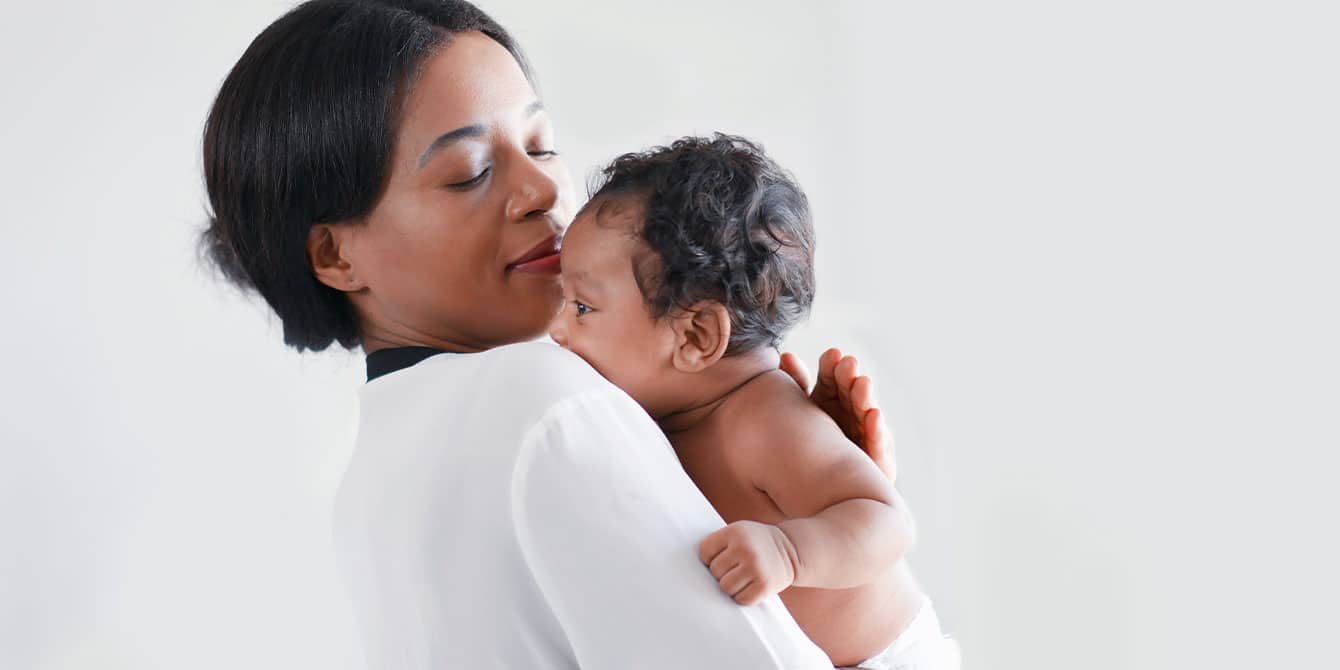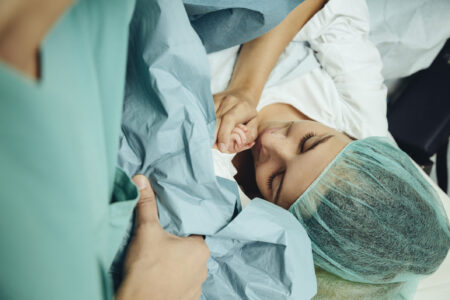C-section swelling may be common, but is it normal to swell above the incision?
Here's how to tell if swelling is normal or a sign of infection.

PorporLing/Shutterstock
C-section swelling is not uncommon, especially because this method of child delivery globally accounts for 1 in 5 childbirths, according to the World Health Organization (WHO).
A C-section procedure involves two incisions (cuts): one on the abdomen and one on the uterus. The abdominal incision can be a vertical cut between your navel and pubic hair or a horizontal cut on your lower belly (the bikini cut). According to Monte Swarup, MD, FACOG, board-certified OB-GYN and founder of HPD Rx, “Mild swelling above the incision is entirely normal for several weeks following a C-section. Directly above the incision is where a lot of the dissection occurs surgically which leads to swelling there.”
However, occasionally, swelling above the incision after a C-section can result from surgical site infections (SSI), defined as an infection that occurs within 30 days after a surgical procedure. You might also experience more widespread swelling after birth, given that your body doubled its blood volume to support the pregnancy, and that doesn’t disappear overnight. Here’s what to look for to determine if your C-section swelling is normal or could be related to an infection.
Related: Recovering from a C-section? What you need to keep in mind, mama
Motherly's Digital Classes
What causes swelling after a C-section?
General swelling after a C-section is often reported postpartum, especially on the legs (including the feet and ankles). This is because of the fluid accumulation from pregnancy and the IV fluids administered during the surgical procedure. The swelling should subside with time as your body gradually releases the fluids.
But if you only notice swelling on one leg, you should notify your doctor, and get an in-depth examination to rule out other causes like a potential blood clot.
Experts also recommend seeing your doctor for swelling on the hands, face, and eyes after a C-section, as they may be symptoms of postpartum preeclampsia (high blood pressure occurring after delivery).
Tips to help with swollen feet after C-section
Like any other surgical procedure, a C-section is a major operation. It will take some time to heal after birth and feel like yourself again. But you can help your recovery and reduce swelling by following the tips below.
- Reduce salt intake, as salt contains sodium which can contribute to water retention. Instead, consume potassium-rich foods—sodium’s counterpart, to balance the fluids in your system and reduce water retention. Potassium-rich foods include bananas, spinach, broccoli, sweet potatoes and cucumbers
- Stay hydrated. Increasing water intake can help flush out excess fluids
- Wear compression socks if your doctor recommends them. The compression socks apply gentle pressure to your legs to reduce the swelling and promote blood flow to the heart
- Elevate your legs above the level of the heart using pillows
- Regular, gentle movement is also necessary, but at your own pace
- See your doctor if your feet remain swollen for a period longer than three weeks
Related: 8 natural C-section recovery tips to help you feel better fast
What to know about C-section swelling at the incision
Surgical site infections like hematoma and seroma, which occur in an estimated 2% to 5% of women after a C-section, can cause swelling above the incision.
Hematoma refers to the collection of blood, while seroma is the collection of fluid that builds up under the surface of your skin around the site of incision. With hematoma and seroma, there is a risk of the partial or total opening of the incision stitches, making it easy for bacteria to gain access and cause infections.
Symptoms of a C-section surgical site infection
According to researchers, at least one of the following could be a sign or symptom of an infection at your C-section incision:
- Localized pain or tenderness
- Localized swelling
- Heat (skin is hot to touch)
- Redness
Risk factors for a surgical site infection
Some risk factors for surgical site infections after a C-section include:
- Emergency delivery
- Previous C-section
- Increased blood loss during delivery
- Duration of labor longer than 12 hours or extended surgery time (longer than 38 minutes)
- Incision length greater than 16.6 cm
- Health conditions such as pregestational/gestational diabetes and hypertension
- Lack of prenatal care
- Lack of preoperative antibiotics (antibiotics administered before surgery to prevent infections)
Related: What to expect during a C-section: 27 things I wish I’d known
Surgical site infections can cause health problems postpartum
Surgical site infections can be frustrating for a new mom still recovering from surgery and, simultaneously, caring for a newborn. Studies suggest that post-cesarean surgical site infections are a significant cause of extended stay in the hospital and can cause health problems for the mother—some people reported wound pain at six to seven months postpartum, and some others had reports of chronic urinary incontinence lasting until six years later. Plus, people who had a C-section are 20 times more likely to be down with infections than people who had a vaginal delivery.
It’s always a good idea to keep your doctor in the loop during recovery, and don’t hesitate to inform your healthcare provider if you notice symptoms like high fever, discharge or clots on the incision, worsening pain, and of course swelling above the incision. According to March of Dimes, a postpartum checkup is necessary 2 weeks after a C-section, so your doctor can inspect the incision and check on your healing progress.
Sources
Kawakita T, Landy HJ. Surgical site infections after cesarean delivery: epidemiology, prevention and treatment. Matern Health Neonatol Perinatol. 2017;3:12. Published 2017 Jul 5. doi:10.1186/s40748-017-0051-3
Mizell J, Rosen M, Chen W. Complications of abdominal surgical incisions. Published 2022 July 28.
Sung S, Mahdy H. Cesarean Section. StatPearls Publishing. Published 2022 April 21.
Zejnullahu VA, Isjanovska R, Sejfija Z, Zejnullahu VA. Surgical site infections after cesarean sections at the University Clinical Center of Kosovo: rates, microbiological profile and risk factors. BMC Infect Dis. 2019;19(1):752. Published 2019 Aug 28. doi:10.1186/s12879-019-4383-7
Zuarez-Easton S, Zafran N, Garmi G, Salim R. Postcesarean wound infection: prevalence, impact, prevention, and management challenges. Int J Womens Health. 2017;9:81-88. Published 2017 Feb 17. doi:10.2147/IJWH.S98876
Featured experts
Monte Swarup, MD, FACOG, is a board-certified OB-GYN and founder of HPD Rx.
